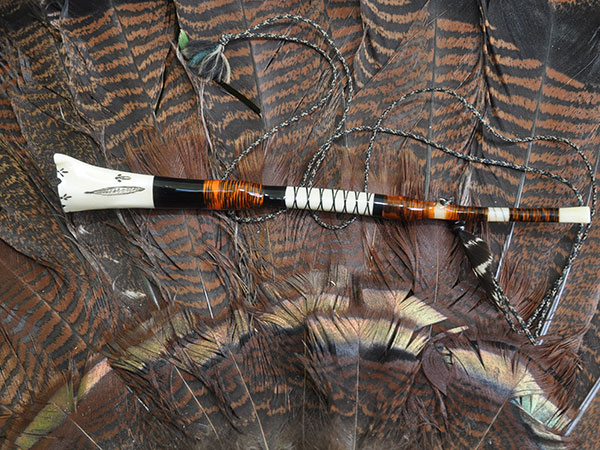
This Birdman Wingbone call was made by Jay Burnworth of Dola, Ohio.
Does a problem gobbler have you stumped? A wingbone call can bring him strutting into shotgun range when nothing else will because it makes turkey sounds he has not heard before.
Wingbone calls may be the oldest manmade turkey calls. Perhaps the Native Americans showed Pilgrims how to blow across leaves held between their thumbs to imitate turkey yelps, but we will never know because leaves do not survive antiquity.
Jay Burnworth of Dola, Ohio has taken the telescoping of a humerus, ulna and radius in a wing to the level of a modern art form. Now 77, he began hunting turkeys in 1980.
"I hunt six or seven states a year," he said. "I made my first wingbone in the early 1990s. I read that wingbones have been found in Pueblo Indian ruins, so there must be a good reason."
He made his first one from a wing he brought home after a hut in Southern Ohio. Now, he makes 100 Birdman Wingbones annually with bones from all over the U.S.
"Before I made wingbones, I used boxes and slates," he said. "The first one I made one was not very good. But, I kept making them for landowners who let me hunt. Everybody uses boxes slates and diaphragms and that is the reason wingbones are so effective. Turkeys have not heard them before."
Burnworth said one of the best uses of a wingbone is a locator call. A gobbler answers when he won't answer anything else. They work in many other situations when other calls do not.
"I was hunting in Pennsylvania last year when I located two toms that had six hens. I didn't think I could get them to come, but kept calling every five or 10 minutes until both of them were answering. One eventually came into range. He had 1-inch spurs and a 10-inch bird. He was at least a three-year-old, so he had been hunted many times."
A wingbone takes more practice to master than other calls, which is a big reason hunters are gun-shy of them. Burnworth wears his call on a lanyard around his neck. When he anticipates seeing a gobbler strut into range, he drops the call it inside the bib of his overalls to protect it.
"Wingbones are fragile," he said. "Once, after I found a good spot, I dropped my call as I was getting ready to sit down. I sat on it and broke it. They get brittle with age. If I cross a creek, I dunk it in the water to keep the bones from drying out. Wetting the call also makes it sound better."
To use the call, he kisses the tip, which has rubber washers to create a mouthpiece. He pinches the trumpet end between a thumb and forefinger, wrapping one hand around the other. Moving his hands and fingers changes the tone and volume or projects sounds in different directions.
"You have to move it around to find the best spot for your lips," he said. "I put mine in the corner of my mouth. It makes yelps, cuts, purrs, kee-kees and gobbles. But, it doesn't work well on windy days because it doesn't much volume."
To make a call, Burnworth cuts off the joints, boils the bones and allows them to dry. Then he grinds the ends until they slip inside one another. The humerus makes the trumpet end, the ulna the midsection and the radius the mouthpiece. The length of the mouthpiece determines the tone. Smaller hen bones give the call higher pitch while larger gobbler bones create lower pitch. Burnworth prefers jake bones. He glues the bones together with epoxy, adds laser engraving and ink drawings that can include personalization before applying a Flex Coat finish.
For more information, call Jay Burnworth, Birdman Wingbones, (567) 674-7716.
